Visible via amateur telescopes near Big Dipper.
Posted from WordPress for Android via my Samsung smartphone. Please excuse any misspellings. Ciao, Jon
Sunsets, Stars, West, Wind
Visible via amateur telescopes near Big Dipper.
Posted from WordPress for Android via my Samsung smartphone. Please excuse any misspellings. Ciao, Jon
http://www.skyandtelescope.com/howto/basics/How_to_Start_Right_in_Astronomy.html
Good advice from Sky & Telescope
Posted from WordPress for Android via my Samsung smartphone. Please excuse any misspellings. Ciao, Jon
Bellatrix, Orion’s third brightest star, means Female Warrior | Tonight | EarthSky.
Female Warrior. I like it (for obvious reasons). Female Conqueror is even better, but I’ll settle for Warrior.
I went outside Wednesday evening to photograph our exterior Christmas lighting decorations. As I walked down the front steps, I could see most of Orion rising in the east. The Hunter seemed to be reclining in a dreamy, wispy, foggy pose. I couldn’t resist taking a couple of photos, the best of which is displayed below:
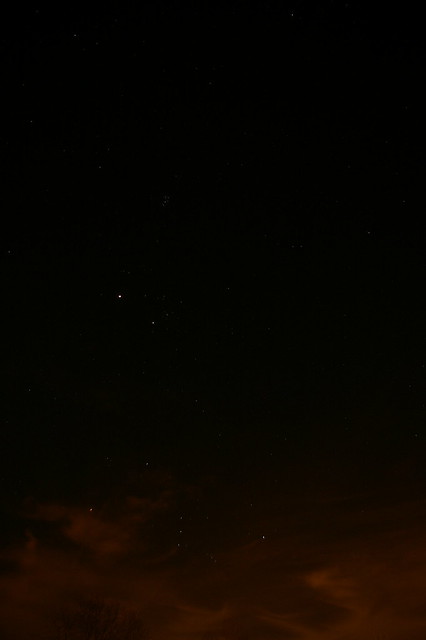
The new moon occurs tomorrow just eight minute’s past four o’clock in the afternoon. I reviewed the sun rise and moon rise times for today, tomorrow and the next day as compared to the time the new moon happens. And, once again, the ‘holy grail’ of observing a moon less than one day from dying or one day new-born eludes me. Tomorrow morning, on the 13th of November, 2012, moon rise occurs at 6:41 a.m. Central, just twenty minutes before the sun rises. If that wasn’t ‘bad’ enough, I’ll be driving the van for the Tuesday commute to work at that time. My final rider pickup occurs at that time, so I may be able to take a couple of minutes with my binoculars to see if I can see the almost dead moon about eight hours before it is reborn as the new moon. I don’t have high hopes though, as twenty minutes before sun rise is quite bright and the eastern horizon will be hazy unless I’m extremely lucky. And the chance of catching any sign of the extremely young moon (less than an hour old by sun set tomorrow night) is even slimmer than the crescent moon would appear at that time.

I woke up knowing the temperatures had plummeted to the lower 20s overnight, leaving the sky crystal clear and killing the wind we’ve had for the past week. Since my kitchen is completely unusable for the next week or so, I decided to pack up the van for the Monday commute, start it up (since frost completely covered all the windows) and gather up my camera equipment for an pre-dawn frigid photo shoot of the nearly dead moon.
 I drove the still cold and nearly empty van up the hill to the dead-end in front of City Hall. I left the van running to continue the process of thawing out the windows and doors while I took the tripod and camera a few feet back up the hill to the east side lawn of City Hall. I could barely see the new risen moon through the leafless trees lining the south and southeastern horizon. I found a spot where the moon just clear the tree limbs and setup the camera equipment. I took my first photo at 5:47 a.m., about nineteen minutes after the moon rose (at 5:28 a.m.). I tried various settings and exposures, while trying to keep my hands warm and not shake the camera too much. I took several unsatisfactory photos for about ten minutes and then returned to the van. I needed to fill up the gas tank and get something warm to drink before heading south to pickup my first setup of riders. My local rider had the day off because he’s a federal employee and today is the day set aside to observe and honor our veterans.
I drove the still cold and nearly empty van up the hill to the dead-end in front of City Hall. I left the van running to continue the process of thawing out the windows and doors while I took the tripod and camera a few feet back up the hill to the east side lawn of City Hall. I could barely see the new risen moon through the leafless trees lining the south and southeastern horizon. I found a spot where the moon just clear the tree limbs and setup the camera equipment. I took my first photo at 5:47 a.m., about nineteen minutes after the moon rose (at 5:28 a.m.). I tried various settings and exposures, while trying to keep my hands warm and not shake the camera too much. I took several unsatisfactory photos for about ten minutes and then returned to the van. I needed to fill up the gas tank and get something warm to drink before heading south to pickup my first setup of riders. My local rider had the day off because he’s a federal employee and today is the day set aside to observe and honor our veterans.
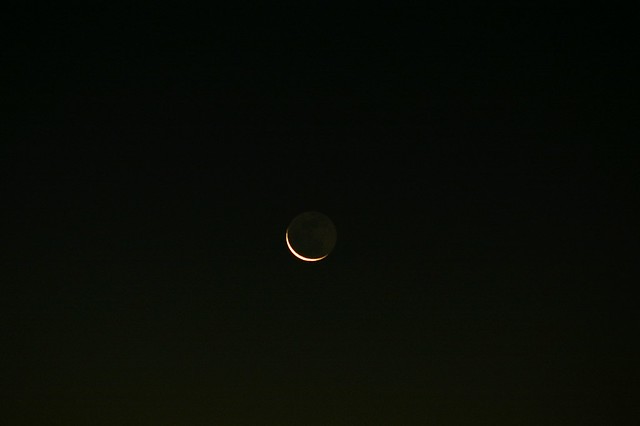
After filling up the van, I drove back up the hill so I could cross Main Street using the light between City Hall and the Library and just happened to look east again. I noticed the colors caused by twilight and pulled into the Library’s parking lot for a second photo shoot. I quickly reset up the camera and took another ten minutes worth of photos before continuing on to Scooters for a warm mocha and a caramel apple scone.
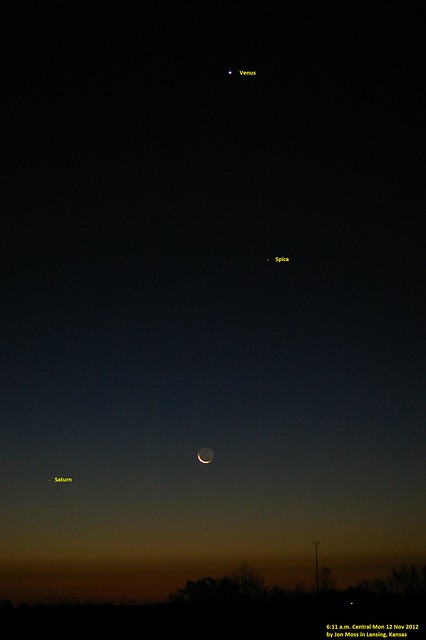
I downloaded the photos from the camera and reviewed them. I threw away most of the first photo shoot because I forget to set the two second delay timer and most of them were blurry. I logged into my Astronomy.com account and downloaded the sky dome for the east-southeastern horizon to confirm and label the objects photographed above.
I had completely forgotten that Saturn had finally come out from behind the sun to become visible once again in the early morning. In fact, Saturn rose just nine minutes after the moon did, although my camera did not capture it in my first photo shoot, probably because it was hiding behind some tree limbs.
I also photographed the Big Dipper, Orion, Canis Major and the Pleiades, but decided not to share the photos with anyone yet. Because I didn’t change from my telephoto lens to my normal one, I did not get all the stars in the handle of the Big Dipper nor did I capture all of the stars in Orion.
I’ll probably miss this weekend’s meteor shower, as I will be otherwise occupied during the day and not in a location that will provided dark enough skies to properly observe a shower. A solar eclipse occurs tomorrow, but only for those excessively lucky people who live in the South Pacific. For more of what’s up this week, visit Astronomy’s the Sky this Week website.
 Despite a busy weekend of van maintenance (oil change/tire rotation), hair maintenance (shampoo, cut & style), yard maintenance (leaves, leaves and more leaves and now pine needles), home improvement projects (refinishing lower kitchen cabinets) and exercise (very long walk with Apollo), I squeezed in an hour of star gazing after a night out with Terry and friends at Jack Stack on the Plaza. I’ve been wanting to get the scope out for a couple of weeks now, but the evening skies have not cooperated, remaining hazy at best or completely cloud covered at their worst. Upon parking the car in the driveway Saturday night, I looked up and decided the skies looked good enough to attempt some star gazing. I didn’t even take my purse into the house. I drug the telescope out of the garage and began hunting down more targets on my Astro Quest observing award checklist.
Despite a busy weekend of van maintenance (oil change/tire rotation), hair maintenance (shampoo, cut & style), yard maintenance (leaves, leaves and more leaves and now pine needles), home improvement projects (refinishing lower kitchen cabinets) and exercise (very long walk with Apollo), I squeezed in an hour of star gazing after a night out with Terry and friends at Jack Stack on the Plaza. I’ve been wanting to get the scope out for a couple of weeks now, but the evening skies have not cooperated, remaining hazy at best or completely cloud covered at their worst. Upon parking the car in the driveway Saturday night, I looked up and decided the skies looked good enough to attempt some star gazing. I didn’t even take my purse into the house. I drug the telescope out of the garage and began hunting down more targets on my Astro Quest observing award checklist.
 I did make one trip inside to retrieve my binoculars, pocket star atlas, clipboard and checklist. I used Jupiter to re-align the finderscope and spent several minutes enjoying an interesting moon alignment (see image above).
I did make one trip inside to retrieve my binoculars, pocket star atlas, clipboard and checklist. I used Jupiter to re-align the finderscope and spent several minutes enjoying an interesting moon alignment (see image above).
 Using binoculars, I easily found the Andromeda galaxy and the Double Cluster (between Perseus and Cassiopeia). I checked off two stars from my list, Algol in Perseus and Gamma Cassiopeiae. Since the constellation Pegasus was nearly directly overhead, I went hunting for the Triangulum galaxy, also known as M33. I could barely see the three stars in the constellation Triangulum, but no matter how hard I searched (with binoculars, not naked eye), I could not find this galaxy. I should have been able to trace a line from M31 through two stars in the constellation Andremeda (Mu and Beta Andromedae) to find M33, but I was defeated once again by urban (and prison) light pollution. I had hoped to stumble upon it with binoculars, especially since M31 was so easily visible and found (almost naked eye Saturday night, but not quite).
Using binoculars, I easily found the Andromeda galaxy and the Double Cluster (between Perseus and Cassiopeia). I checked off two stars from my list, Algol in Perseus and Gamma Cassiopeiae. Since the constellation Pegasus was nearly directly overhead, I went hunting for the Triangulum galaxy, also known as M33. I could barely see the three stars in the constellation Triangulum, but no matter how hard I searched (with binoculars, not naked eye), I could not find this galaxy. I should have been able to trace a line from M31 through two stars in the constellation Andremeda (Mu and Beta Andromedae) to find M33, but I was defeated once again by urban (and prison) light pollution. I had hoped to stumble upon it with binoculars, especially since M31 was so easily visible and found (almost naked eye Saturday night, but not quite).
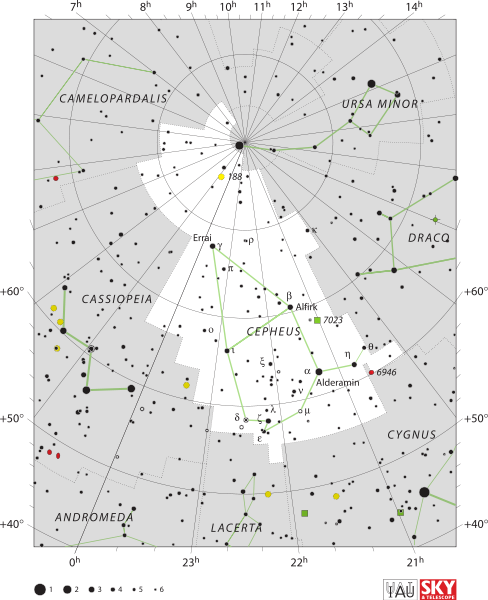
I became more chilled as the evening wore on, neglecting to put on my sweater and just ignoring the 40 degree temperatures. The lack of wind helped shore up my illusion of warmth. I thought I’d try one last object before packing the scope up and returning it to the garage. I went hunting for the Garnet star in the constellation Cepheus. With my naked eyes, I could barely make out some of the stars that form the ‘house’ asterism. I knew the general area to look for Mu Cephei so I aimed my binoculars between the alpha and delta stars. Whoa! Way, way too many stars visible, thanks to the backdrop of our own Milky Way galaxy. Staring again with just my eyes, I squinted against the light pollution, but could still only see some of the anchor stars of Cepheus and no Milky Way stars.
I gave up, because I knew I would need to study several star atlases closely and device a star hop from Alpha Cephei to Mu Cephei, a trail I would need to memorize, so I wouldn’t have to take my reading glasses on and off while attempting to observe.

Another star trail I need to work on is finding M15 in the constellation Pegasus. I really shouldn’t have had any trouble finding M15, since you can draw a nearly strait line from Theta Pegasi through Epsilon Pegasi to point to that globular cluster. Either my skies were not dark enough, or I kept misidentifying Enif (Epsilon Pegasi) in my binoculars.
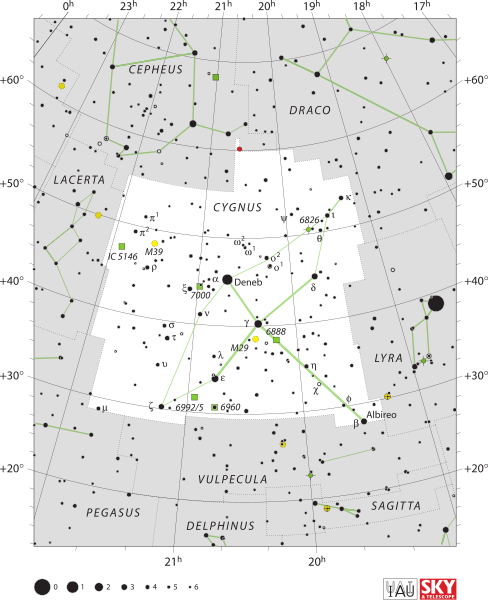 Last week I posted about counting stars, assuming I’d have ample opportunities to star gaze any evening, thanks to one of the worst droughts since the early 20th century. And that same evening, a week ago on Monday the 8th of October, I took my binoculars with me to the backyard at 8:30 p.m. and let my eyes adjust for night vision for fifteen or twenty minutes. A few wispy clouds striated the night sky and a high school football game just a block away to my northeast made for less than stellar seeing. I estimated I could see fourth magnitude stars in the constellation Cygnus, but knew I could see better if the conditions improved bit. I’ve seen more stars in that constellation from the exact same spot in the past, including last year’s star count. I decided not to report my findings on the 8th to the Great World Wide Star Count web site, opting to observe on a succeeding evening.
Last week I posted about counting stars, assuming I’d have ample opportunities to star gaze any evening, thanks to one of the worst droughts since the early 20th century. And that same evening, a week ago on Monday the 8th of October, I took my binoculars with me to the backyard at 8:30 p.m. and let my eyes adjust for night vision for fifteen or twenty minutes. A few wispy clouds striated the night sky and a high school football game just a block away to my northeast made for less than stellar seeing. I estimated I could see fourth magnitude stars in the constellation Cygnus, but knew I could see better if the conditions improved bit. I’ve seen more stars in that constellation from the exact same spot in the past, including last year’s star count. I decided not to report my findings on the 8th to the Great World Wide Star Count web site, opting to observe on a succeeding evening.
As the week wore on, I began to despair. Clouds rolled in on Tuesday or Wednesday and stubbornly blocked the sky, but didn’t drop much rain, until Sunday morning. I am overjoyed for the rain, but disappointed at the lost observing opportunities. Rain all day, but please dissipate when the sun sets.
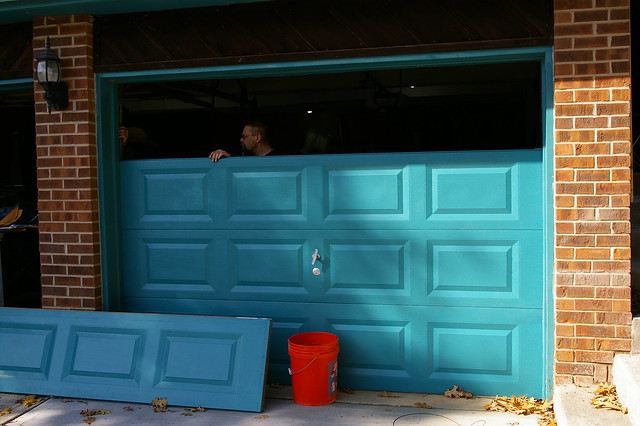 My next opportunity to observe came Sunday evening, after a long day of hanging garage doors. We called it quits around 8:30 p.m. and sent my dad home to get some rest just after 9:00 p.m. I didn’t remember about the star count until Monday morning, when I stepped outside and saw Venus, Jupiter, Sirius, the Pleiades and Orion for the first time in a week. I went back in and got my binoculars for a quick fix of planet, star, open cluster and nebula observing before leaving on the morning work commute.
My next opportunity to observe came Sunday evening, after a long day of hanging garage doors. We called it quits around 8:30 p.m. and sent my dad home to get some rest just after 9:00 p.m. I didn’t remember about the star count until Monday morning, when I stepped outside and saw Venus, Jupiter, Sirius, the Pleiades and Orion for the first time in a week. I went back in and got my binoculars for a quick fix of planet, star, open cluster and nebula observing before leaving on the morning work commute.
Monday evening, I got home to more progress on the garage doors and wispy clouds during sunset. Grrr. I took Apollo on a short walk after eight o’clock. During our walk, I kept trying to look up at Cygnus, but with it being directly overhead, I risked tripping over something if I tilted my head back far enough to observe. Once back home, I went right back outside and laid down on my patio. After fifteen minutes or so, I determined I could see fourth and possibly some fifth magnitude stars in the constellation.
 I texted my husband, asking him to bring me my binoculars. I didn’t want to get up (still very sore from the garage door project and my strength training exercise class at work) and/or ruin my night vision. He graciously brought them to me, and I went looking for the double cluster in Perseus. I think I found it, but I couldn’t’ confirm it because my star atlas was locked in the backseat of the car on the other side of the house, where I’d left it after my final stint as a volunteer staff member at a Powell Observatory public night. Saturday night, the one where thunderstorms and lightning further discouraged star gazing.
I texted my husband, asking him to bring me my binoculars. I didn’t want to get up (still very sore from the garage door project and my strength training exercise class at work) and/or ruin my night vision. He graciously brought them to me, and I went looking for the double cluster in Perseus. I think I found it, but I couldn’t’ confirm it because my star atlas was locked in the backseat of the car on the other side of the house, where I’d left it after my final stint as a volunteer staff member at a Powell Observatory public night. Saturday night, the one where thunderstorms and lightning further discouraged star gazing.
Tonight, after raking the front lawn under the odious burr oak tree, I will try to catch the new moon just after sunset and then drive to northwest Leavenworth County to places I frequented in my youth. I will repeat the star count and compare notes, so to speak.
If you haven’t observed and reported your star count findings yet, you still have four days. The deadline is this Friday, October 19, 2012.
 I missed the opportunity to count stars over the weekend. Clouds obscured the heavens Friday and Saturday night, but I had absolutely no excuse not to step outside Sunday evening and participate in the Great World Wide Star Count. Thank goodness that Sky & Telescope‘s Facebook feed reminded me with their article ‘A Star Count for Everyone‘ this morning.
I missed the opportunity to count stars over the weekend. Clouds obscured the heavens Friday and Saturday night, but I had absolutely no excuse not to step outside Sunday evening and participate in the Great World Wide Star Count. Thank goodness that Sky & Telescope‘s Facebook feed reminded me with their article ‘A Star Count for Everyone‘ this morning.
I checked my local five day forecast and I should be able to find Cygnus and count stars tonight and Wednesday. Tuesday, Thursday and especially Friday are iffy. This year, I’m going to try to do it from a couple of different locations, not just my backyard (like I did last year).
Here’s all you need to know to participate:
All you’ll need are a clear evening sky sometime between October 5th and 19th, your own two eyes, and a set of simple star charts. First, download the handy five-page activity guide (available in 16 languages) and print the star charts. If you live in the Northern Hemisphere, you’ll be looking high up for the constellation Cygnus, and its Northern Cross asterism. If you’re south of the equator, the target area surrounds the Teapot in Sagittarius. Each of the seven maps shows stars down to a different magnitude limit, plus one for a cloudy sky.
Then, after stepping out under the early-evening sky and letting your eyes adjust to the darkness, match one of the charts to what you see overhead. Step back inside and report what you’ve found online. You’re done! (Unlike many contests, you can enter more than once! You might be surprised by how much the sky’s darkness can vary from night to night.)
A Star Count for Everyone, Sky & Telescope, Oct. 5, 2012
I received the alert from my calendar ten minutes before five o’clock Wednesday morning. I wanted to make sure I woke up early enough to have dark skies (well, as dark as they get in my neck of the woods) to observe the Beehive Cluster aligned with Venus and the waning Moon. I planned ahead and had all my equipment ready to go before I went to bed Tuesday night. I subscribe to several astronomy related RSS feeds and always review Astronomy.com‘s “The Sky This Week” as soon as it’s updated to make sure I mark my calendar for interesting observation events. The following is an excerpt from this week’s article:
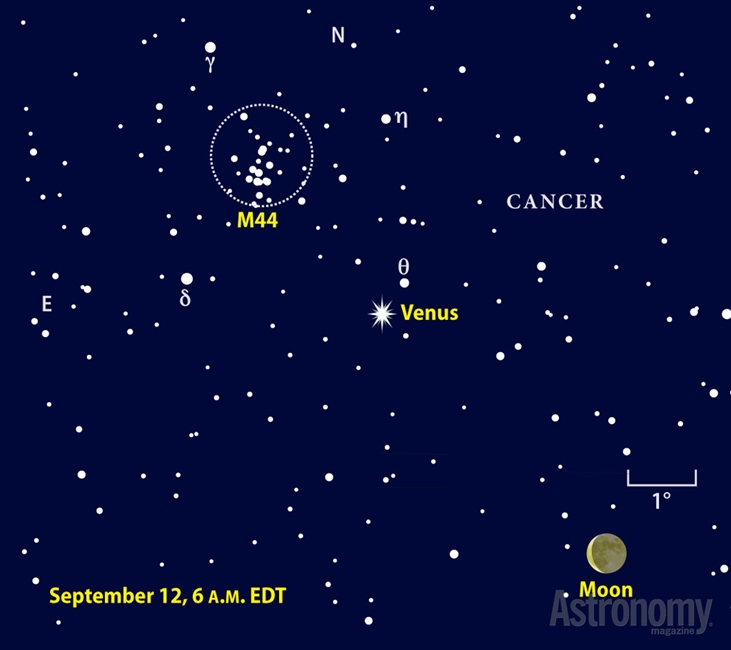
Wednesday, September 12: If you enjoy seeing spectacular celestial alignments, this is the morning for you. A waning crescent Moon stands 4° southwest of brilliant Venus before dawn while the planet resides 3° southwest of the Beehive star cluster (M44). Although the scene will be lovely with naked eyes under a dark sky, binoculars will deliver the best views. To see the Beehive clearly, you’ll need to observe before twilight begins around 5 a.m. local daylight time. The Moon and Venus remain stunning until about 15 minutes before the Sun rises (from Astronomy.com‘s “Sky This Week” article).
A few stray small puffy clouds drifted around the night sky. A slight breeze blew in from the south or southwest, but my house sheltered the driveway where I setup the tripod and camera. I could not see any of the stars in the constellation Cancer with my naked eye. I live less than ten miles due west, as a bird flies, from the Kansas City International Airport, and the rest of Kansas City sprawls continuously south along the eastern horizon down to the southeast quadrant. Seeing anything faint below 20 degrees above the horizon is not easily accomplished.
With my binoculars, I could see the stars that make up Cancer, and I could clearly see the Beehive Cluster (M44). I affixed my telephoto lens to my camera, but looking through the tiny viewfinder I could only see Venus. So I guessed as best I could with placement relative to Venus and took a few photos. I tried to capture a few other interesting objects much higher in the sky, like Jupiter, Orion’s sword, and the Pleiades again.
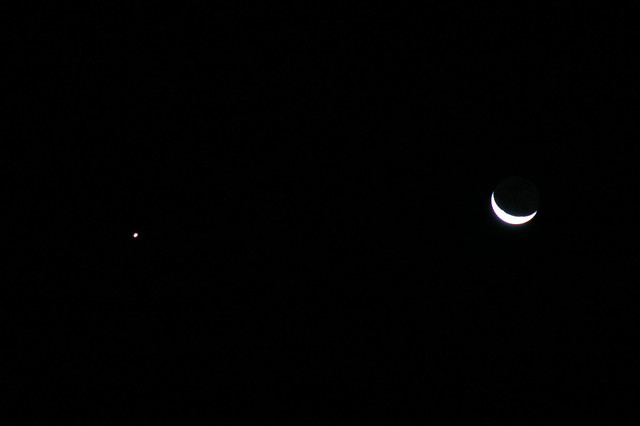
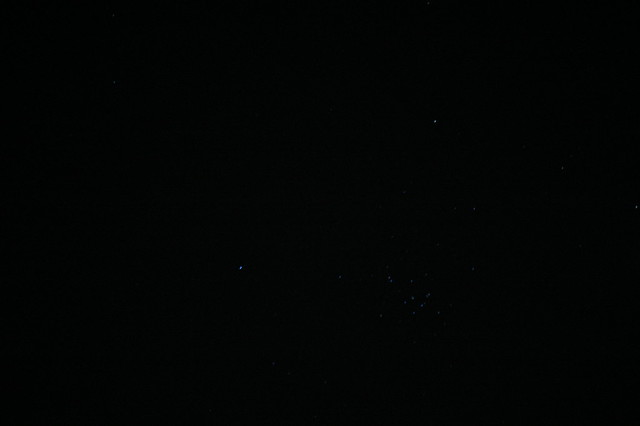

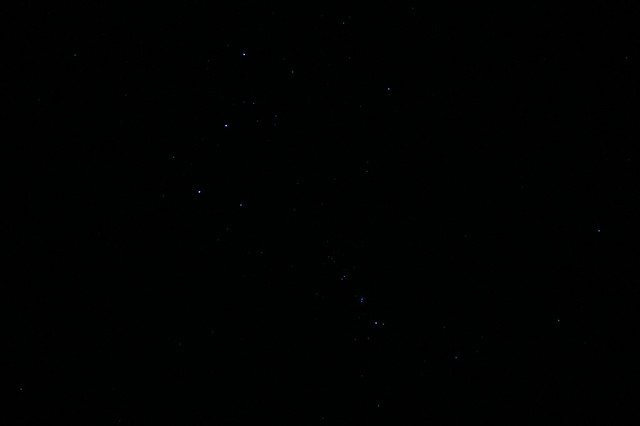
Click here to see the entire album of photos from Wednesday morning.
Thursday dawned completely overcast, with rain scheduled for the entire day. We need it so I’m not complaining.
Friday night I’ll attend the club’s local star party and have already organized my observing list so I can make great strides towards my Astro Quest observing award. Friday morning, if I can manage it after observing late into the night, I hope to capture the last glimpse of the old moon before it turns new around nine o’clock Saturday evening.
I stepped outside at a quarter past five o’clock to gauge the quality of the skies. Clear, but not as clear as yesterday’s crisp clean views of Venus, Jupiter, Orion and the waning Moon. Not that I complained. I keep the camera and tripod close to the front door so it’s just a matter of a minute or two before I can snap a couple of photos to share.
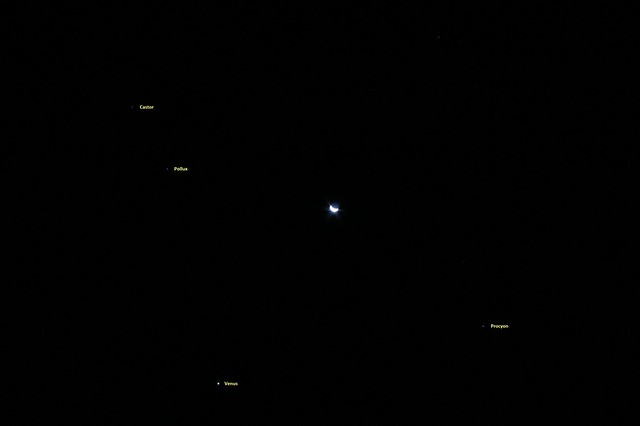
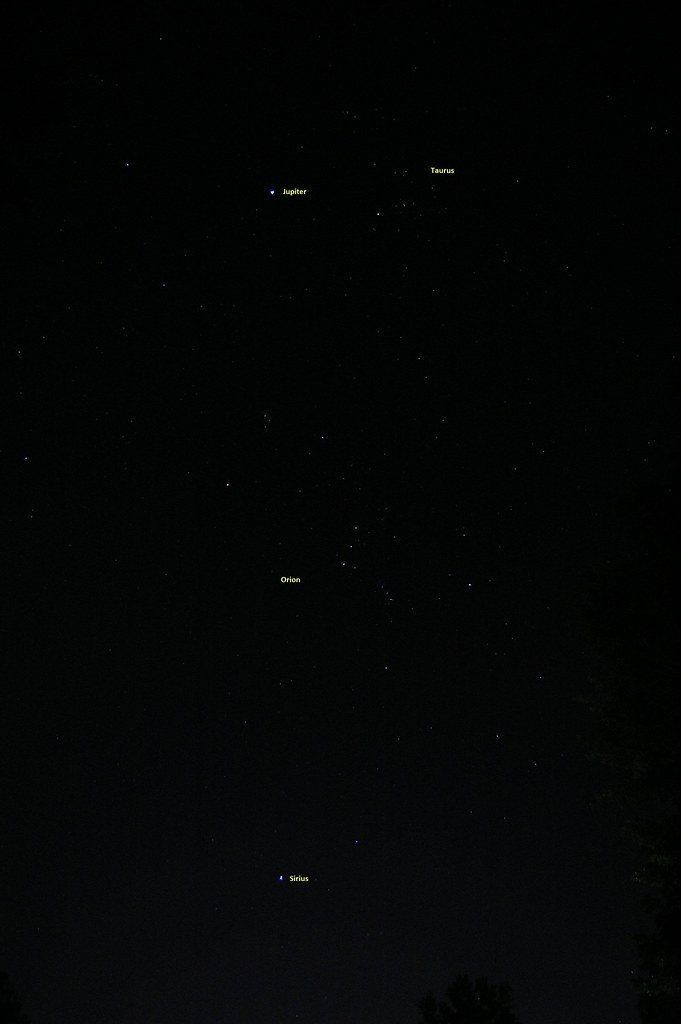
Both of these photos taken between 5:25 and 5:30 a.m. this morning, so here’s a star chart to help you identify the planets, stars and constellations from my location at that time looking east-southeast.
Tomorrow morning, the waning moon catches up to Venus in Cancer and as an extra treat, I plan to search for M44, the Beehive Cluster, found in the chest of that Crab constellation. This open cluster is visible to the naked eye and even more so to binoculars. Perhaps my camera, with the telephoto lens mounted, won’t be too shabby either.